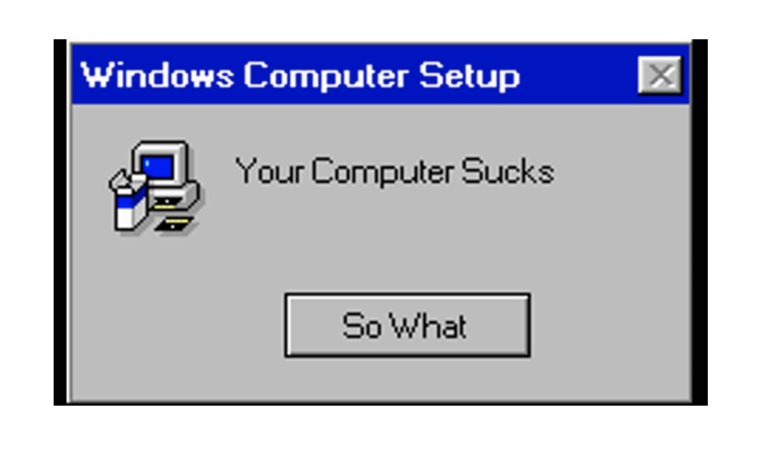
Experts say the most efficient way to keep your website hidden from the world is to simply build a stock site, sit back, and wait for users to never find you. Fortunately, we’re here to provide some insider tips for the real go-getters proactively seeking to snuff out their web traffic before they can be found.
Use this top 10 countdown to create the slowest, most cleverly broken, least user-friendly website out there.
10. Don’t Update Contact Forms
Starting in at number ten is one of the banes of web development: contact forms. Who actually wants users or clients to be able to contact you? Bah! You don’t need to be interrupted in the middle of the work day by hordes of calls and emails demanding to give you money. Keep your old contact form plugins out-of-date and consistently test to make sure form submissions are not going through. Users should never be led to believe there’s an issue with the website. No, a truly tanked website will make customers think they’re being deliberately ignored. This is the only way to guarantee you won’t be hearing from them again.
Think of your contact form as a digital black hole: anything can go in, but nothing comes out. Note: be sure to always remove any sort of form tracking (such as Google Tag Manager) just to be safe.
9. Buy Local Web Hosting
Woohoo! You finally purchased that modern, avant-garde domain name for a sweet deal, and you’ve selected one of the least technical content management systems you can find. Now all you need is an equally obscure place for your part-time web developer cousin Vinnie to host it all! Regardless of which service you purchased your domain name through, you’ll want to get on board with the smallest local Mom and Pop website hosting service you can find. (The more obscure the better). Stick it to the man over at Amazon and BlueHost — you’re buying local!
8. Rebrand with Minimum Effort
Let’s be honest, the only thing more stressful than rebranding is changing your domain name. Fear not web citizen, you can keep the plethora of old websites active and spread out across the web. In fact, this is a pivotal step in sowing maximum confusion among your followers. Put in the least amount of effort now and thank yourself later!
7. Plugin Mixology 101
The secret is out on plugins and with good reason; there’s nothing better than a fresh, savvy website add-on or module. As with most free things, it’s up to you to make sure you get the maximum allotment here. We recommend a good baseline of at least 50 plugins (but in all reality the sky’s the limit)! Leave the carefully curated plugin collections to the security zealots and performance gurus.
6. Pass the Password Buck
While we love traditional ‘set and forget’ password methodology, we recommend someone else hold onto your login information and credentials for you. You trust bank tellers with your money, so why not trust your neighbor with your website password? There are several secure password management solutions out there, but then you are subjecting yourself to remembering another master password, and that just won’t do. Take our word for it and outsource your website, domain, and name service logins to a generally unreachable friend or family member.
5. Change Hands Often
Congratulations! You’ve done your homework, put together a hard-earned budget, and successfully outsourced your marketing goals to a very reputable agency. And yet here you are, locked into a contract that will supposedly take months to achieve any discernible results. How can that be?! Change agencies immediately to one that promises instant results at unbelievably low prices.
4. Buy Bad Backlinks
You’ve gotten the ball rolling on your fancy new e-commerce site, and you really want to get the word out there! If you’re on a tight budget, there are still first-rate options for changing your website’s reputation, just not in the direction most companies shoot for. One of these options is purchasing cheap and spam-ridden backlinks. While keeping in mind that top search engines know which sites are selling these backlinks, have no fear that they will reward you for your thriftiness! While meaningful link-building is great if you are inundated with free time, you should really consider this short track to the Google blacklist instead.
3. Go Big or Go Homepage
Building and maintaining multiple pages and menus on a website can be quite a slog. That’s why there’s nothing quite as satisfying as setting up that crisp, newly-minted, single-page site displaying everything to your visitors in one location. The homepage is your masterpiece, and the slow loading times caused by ultra high resolution photos and tons of content will ensure that your visitors spend the appropriate amount of time admiring your works of art. No additional clicks required!
2. Ditch those SSL Certificates
Are you tired of pulling your hair out trying to install an SSL certificate to your obscure hosting platform? We’re here to save you from all the acronym overload: SSL, TLS, and HTTPS. If Google values these certificates so much, they should just install them for you. Better late than never on throwing those old certificates in the shredder!
1. Fend off the Robots
Finally, we’re going to chuck responsibility out the window, and go straight for the number one power source: Robots.txt. Call the exterminators because it’s time to sweep those annoying web crawlers and spiders out the front door and hang a sign up refusing future admittance. Robots.txt acts as that sign hanging on the front door to your website. By enacting something called “disallow all”, we can go ahead and flip that Open sign to Closed. Why give companies like Google and Microsoft a regular tour of your home and then hand them a set of blueprints on their way out? They might not be the worst guests, but they are going to advertise your beautiful house to the world. Stop them in their tracks!

